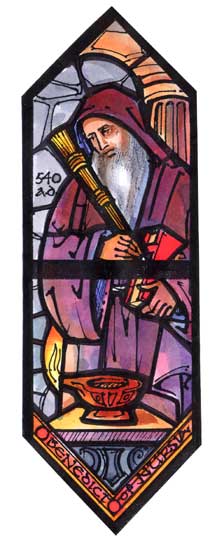|
|
|||

|
|||
Benedict of Nursia
Window
 The Germanic invasions brought the age of classical antiquity to an end. As Europe entered the Middle Ages, cities were abandoned, trade ceased, and life became centered around the estates of petty chieftains. Amidst the chaos, it was the Church that provided stability and continuity with the past; and untold multitudes shared the Story of Jesus with their pagan conquerors, slowly converting them to the Christian faith. This tumultuous period sparked the rise of Western monasticism, shaped most significantly by a monk named Benedict of Nursia. Benedict was born about 480, and grew up under the rule of the Ostrogoths. His family, part of the old Roman aristocracy, sent him to study in Rome, but he was so appalled at the corruption there that at the age of 20, he became a hermit and went to live in a cave. Soon he began attracting disciples and establishing small monasteries. Apparently, not all his attempts were successful; once a faction tried to poison him. This prompted Benedict and a band of loyal followers to withdraw to the remote location of Monte Cassino, where he penned his great contribution to Christendom, the Rule that governed his community. Its two most essential elements were permanence (Monks remained at the monastery for life.) and a willing obedience (both to the Rule and the abbot). In a time of upheaval, these two qualities gave the monasteries great stability. The Rule also offered a balanced pattern of living, dividing each day into periods of work, rest, reading, and especially prayer. The schedule of prayer, which included reciting Psalms and reading other Scriptures eight times daily, has come down to us as the Divine Office. Over the years, Benedictine monasteries became centers of learning, and some ran hospitals, pharmacies, and hostels, as well. About 40 years after Benedict’s death, Monte Cassino was sacked, and most of the monks fled to Rome, taking the Rule with them. From there it spread throughout western Europe, including England, where it became an integral part of Anglican monasticism and spirituality. Benedict has become the most studied monastic in the history of the Church; his wise and balanced teaching has much to offer us all. He is shown with a stave in one hand, representing his Rule, and a Bible in the other, symbolizing the Divine Office. The lamp reflects the Benedictine hallmarks of learning and hospitality.
Like Stars Appearing: The Story of the Stained Glass
Windows of St. George's Episcopal Church, Dayton, Ohio | |||
|
|||
